Museums Doge's Palace | Guggenheim | Correr | Pesaro | Rezzonico | Murano | Accademia | Oriental | Ca d'Oro | Archeological | Querini | Bovolo | Pisani | Fortuny | Rocco | Lace | Marciana | Grassi | Dogana
San Rocco History Art | Location | Opening Hours Tickets | Authorizations
History Art Scuola | Rivalries | Crucifixion | Pilate Ecce Homo Calvary | Official Painter | Snake | Moses Manna | Sin Isaac Jacob | Adoration Temptation Breads | Probatic Pool Last Supper | Olive Garden Resurrection | Pianta | Annunciation Adoration Flight | Innocents Circumcision
The Scuola Grande di San Rocco in Venice - The Chapter Room “The Apparition of Saint Roch” and “The Erection of the Bronze or Brazen Serpent” by Tintoretto
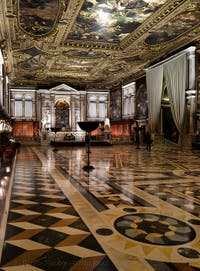
The Chapter Hall From 1575 to 1581 Tintoretto devoted himself to producing the works that occupy the ceiling and walls of the huge chapter house of San Rocco.
Aesthetic pleasure was not the only aim of all these magnificent works.
They also reminded the members of the Confraternity of San Rocco, who met regularly in this room, of their duty of charity towards the poor and the sick.
It should be noted that Mass was celebrated here on Saint Roch, 16 August.
The altar in this superb hall of the Chapter House of the Scuola Grande San Rocco is decorated with The Apparition of Saint Roch.
Tintoretto “The Apparition of Saint Roch”
Oil on Canvas (495 x 246 cm) 1588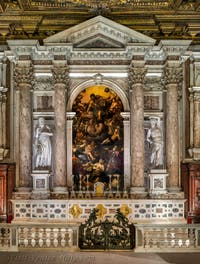
The Apparition of Saint Roch This large canvas, superbly displayed in the altar of the Chapter Room, the upper room of the Scuola Grande, was not entirely painted by Tintoretto.
His collaborators, including his son Domenico Tintoretto, helped him with the work.
Saint Roch is shown seated on the clouds, towering over the figures below him.
The figures, including a cardinal, are much smaller than Saint Roch himself, to further emphasise the importance of the patron saint of the Scuola Grande.
The 21 canvases on the ceiling recount key episodes from the Old Testament:
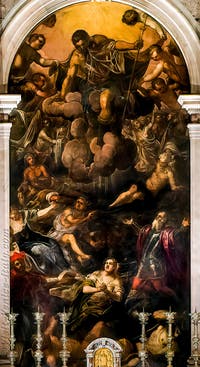
The Apparition of Saint Roch original sin, the sacrifice of Abraham, the vision of Jacob, the Passover of the Hebrews which marks the beginning of their Exodus, the miracles performed by Moses, and the miracles affecting the various prophets of Israel.
The 13 canvases adorning the walls relate episodes from the New Testament, which are in correspondence with the Old Testament:
the Passover with the Eucharist; the trials of the Exodus giving rise to the Hebrews' revolts against Moses and their doubts about Yahweh, with the temptation of Christ in the Desert.Moses is a liberator, Jesus is a saviour.
Jesus multiplies the loaves and fishes, just as Elisha had multiplied the loaves to feed all those who followed him.
Faith in Yahweh, the only God, must be shown by obedience and respect for his Law; faith in God is Love of God, which must be shown by charity towards one's neighbour.
In both cases, true Faith is attachment to God, the sincerity of which is shown by daily practice of the Commandments.
Tintoretto “The Erection of the Bronze or Brazen Serpent”
Oil on Canvas (840 x 520 cm) 1575-1576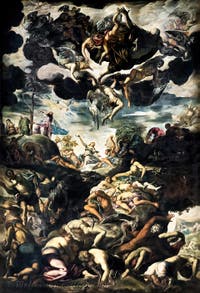
The Bronze Serpent This painting retraces an Old Testament episode quoted in the Gospel of John, chapter III verse 14, to bring it closer to Christ's mission:
“14 Moses lifted up the serpent in the wilderness, and the son of man must also be lifted up
15 so that everyone who trusts may have eternal life through him.
17 For God so loved the world that he gave his only begotten son, that whoever trusts in him should not perish but have everlasting life.”
This episode is found in Numbers, chapter 21 verse 4, where the Hebrew people once again complain about the difficulties and suffering imposed by Moses (and by Yahweh) before reaching the promised land, then
“Yahweh sent against the people the fiery serpents (allusion to pain?) which bit the people, and many of the people of Israel died”.
The people repented, and Moses interceded with Yahweh who said to him:
“Make yourself a burning snake and put it on a pole; whoever is bitten and looks at it, will stay alive.”
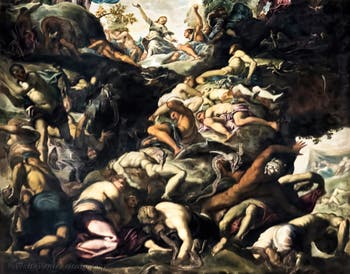
The Bronze Serpent Moses made a bronze effigy of this serpent, and the victims who looked at the bronze serpent remained alive.
The Bronze Serpent, painted in 1575-76, clearly alludes to the plague epidemic then raging in Venice, which could also have been a divine curse!
The lower half of the painting is taken up by a crowd of half-naked people, beset by snakes and dying on the ground.
Some of the chalk-coloured bodies, completely relaxed, are already dead; the others are trying to get rid of the snakes, and are trying to look up at the bronze winged snake with a dragon's head (an allusion to its celestial nature?) hanging from the cross that Moses is showing them in full view.
The upper half of the painting is reserved for the cloud, where Yahweh represented by a robust old man surrounded by numerous angels who seem to be clinging to him.
Through the assistance of those of faith (Moses and Rocco), this work appeared as a message of appeasement and hope for Venice.
History Art Scuola | Rivalries | Crucifixion | Pilate Ecce Homo Calvary | Official Painter | Snake | Moses Manna | Sin Isaac Jacob | Adoration Temptation Breads | Probatic Pool Last Supper | Olive Garden Resurrection | Pianta | Annunciation Adoration Flight | Innocents Circumcision
San Rocco History Art | Location | Opening Hours Tickets | Authorizations
Museums Doge's Palace | Guggenheim | Correr | Pesaro | Rezzonico | Murano | Accademia | Oriental | Ca d'Oro | Archeological | Querini | Bovolo | Pisani | Fortuny | Rocco | Lace | Marciana | Grassi | Dogana
Back to Top of Page

